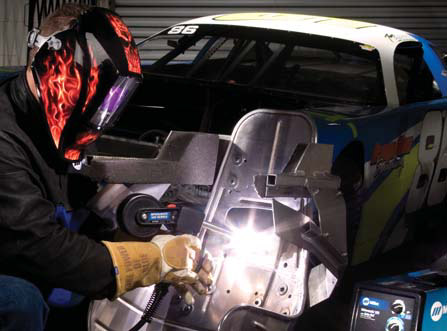MIG Aluminum DIY: Selecting the Right Welder, Spool Gun and Filler Wire for Success in Your Shop
Print Article
One of the hottest trends in welding in the shop or on the farm is adding MIG aluminum capabilities to a Millermatic® all-in-one MIG welder by complementing it with a Spoolmate™ 100 or Spoolmatic® spool gun.
MIG welding aluminum Q&A
Spool guns improve the "feedability" of aluminum wire by locating a small, 1-lb. (
4-inch diameter) spool of wire on a pistol-grip style gun. Because spool guns only need to feed the wire just a few inches before it hits the weld puddle, they eliminate the potential problems created by pushing soft aluminum wire 10 or 15 feet through a regular gun. By using a spool gun, you'll spend less time dealing with a "bird nest" of wire tangled around your drive rolls.
Here are some common questions and answers around the best equipment and filler metals for welding aluminum.

How do I know which spool gun to use with my welder?
First, understand what spool guns are compatible with your welder or the welder you are purchasing. Spool guns are sized to match the performance of the welders they are aligned with (refer to Fig 1). If there are multiple spool guns available, purchase one with the rating and duty cycle that best matches your usage requirements.
As a rule of thumb, higher duty cycle guns are designed for heavier usage, therefore causing the price to increase.
Fig. 1 - Spool Gun/Millermatic® Welder Selection Guide
|
Spool Gun Choice
|
Aluminum Wire Diameter
|
Duty Cycle
|
Matching Welders
|
|
Spoolmate 100
|
.030 or .035 in.
|
135 amps @ 30%
|
Millermatic 142
Millermatic 211
Multimatic 215
Multimatic 220 AC/DC
Multimatic 235
|
|
Spoolmate 150
|
.030 or .035 in. |
150 amps @ 60% |
Millermatic 142
Millermatic 211
Multimatic 215
Multimatic 220 AC/DC
Multimatic 235
|
|
Spoolmate 200
|
.030 or .035 in.
|
160 amps @ 60%
|
Multimatic 235
Multimatic 252
Millermatic 255
Multimatic 255
Millermatic 355
|
|
Spoolmatic 15A, 30A (15 or 30 ft. cables)
|
.030, .035, .047 or .062 (1/16th)
|
200 amps @ 100%
|
Multimatic 235
Multimatic 252
Millermatic 255
Multimatic 255
Millermatic 355
|
Which are the best Millermatic welders for welding aluminum in DIY, farm/ranch, general maintenance and other “occasional” welding applications?
We recommend purchasing a welder capable of welding on 230V input power due to the properties of aluminum. A lot of energy is needed to overcome aluminum’s thermal conductivity rate and melt through the aluminum oxide, which forms on the outside of bare aluminum. In general, 115V welders do not have enough power to overcome these properties and lead to poor fusion while welding.
Therefore, the Millermatics we recommend are the 142, 211, 252, and 255. Pick the machine that meets your needs in regards to welding output, duty cycle, physical size and feature sets. The most popular choice is the Millermatic 211 because of its Auto-Set feature, MVP plug, small size and high output. If it is a larger machine you are looking for, both the Millermatic 252 and 255 are great choices.
Which wire diameter should I use when MIG welding aluminum?
First, consult the welding parameter chart on your machine to see what wires the machine and spool gun are designed to work with. In general thicker wires feed better, while smaller diameter wires work better on thinner material. In general, Miller recommends using either a .030 or .035 in. diameter aluminum wire for most projects around the home.
So what’s the difference between all those grades of aluminum?
Aluminum requires the addition of alloys to increase its strength and to add other qualities suitable for various applications. Their series numbers identifies common alloys. When it comes to MIG welding, there are only two real choices-4043 or 5356 filler wire. They can be used to weld the following alloys: 3000, 4000, 5000 and 6000 series aluminum.
Which wire type do you use for MIG welding aluminum?
There are several wire types for aluminum MIG welding. For most DIYers, 4043 will work best. It is the easiest filler to weld with because it “burns” slower and has silicon added to aid in puddle control. Additionally, the smaller Millermatics (142 and 211) are optimized for this wire. Conversely, if you need a stronger aluminum weld or need improved corrosion resistance, 5356 would be the filler of choice.
It should be noted that 5356 melts considerably faster, so more skill is needed to weld with this filler material. You should also make sure that your spool gun has enough wire feed speed to keep up with the amount of 5356 filler needed when using smaller machines on thicker aluminum base material. Review the specifications for your spool gun/welder combination and compare them to the wire feed speeds noted in Fig. 2.
Fig. 2 - Typical Parameters for 4043 and 5056 Aluminum Wire
|
Wire Diameter
|
Amp Range
|
Wire Speed IPM
|
|
.030
|
100 - 150
|
500 - 600
|
|
.035
|
85 - 190
|
480 - 740
|
|
.047
|
125 - 240
|
360 - 470
|
|
.062
|
190 - 340
|
265 - 420
|
Are there any special storage considerations for aluminum wire?
Yes — don’t open a new package of wire until right before you plan to use it. Aluminum filler wire oxidizes, and this can lead to an erratic arc because oxidation adds resistance, can produce soot and can change the wire’s ability to feed smoothly. Many operators have spent a great deal of time adjusting tension settings, changing contact tips or checking the shielding gas trying to fix the problem when oxidized wire caused the problem. Discard the oxidized spool and open a fresh package.